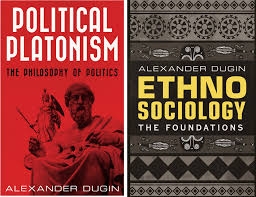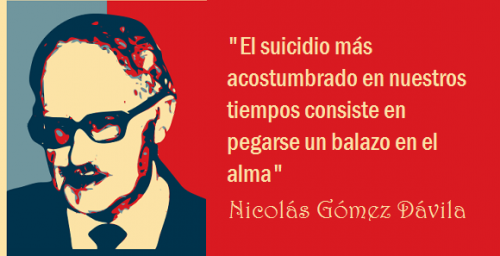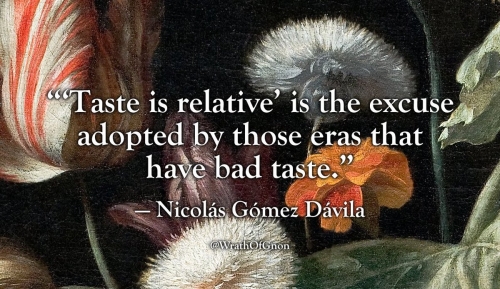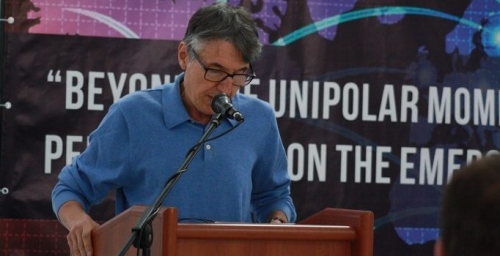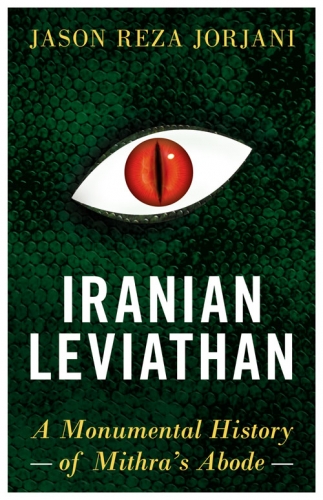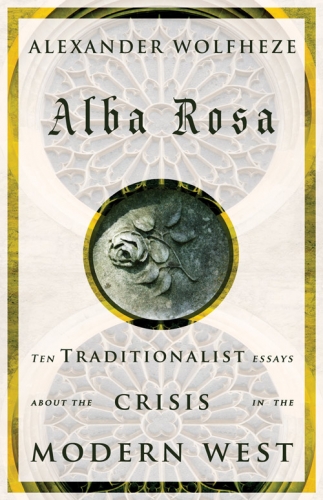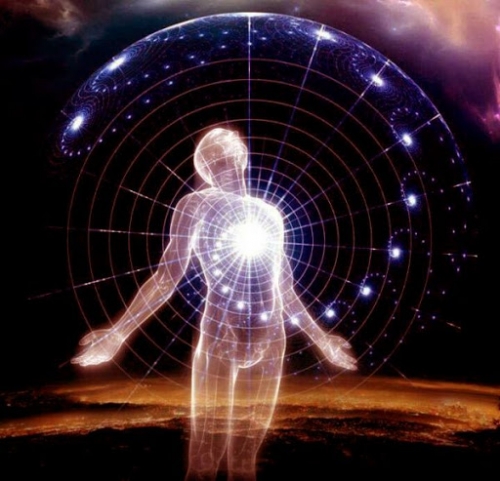
L’homme cosmique et la Tradition primordiale
Conférence Mont-de-Marsan, 28 mars 2020
par Pierre-Emile Blairon
Bonjour, chers amis,
L’Europe : une longue mémoire
Tout le monde peut constater que chaque jour qui passe amène son lot de folie, de mensonges, de turpitudes, de déni de tout ce qui a fait la grandeur de l’Europe depuis des milliers d’années. J’ajouterai cette épidémie de coronavirus qui nous tombe sur le dos, et qui fait partie du dispositif - l’épidémie, créée ou non par l’Homme, est l’un des éléments majeurs de la conjonction des catastrophes d’une fin de cycle.
L’heure est donc à l’urgence.
Je veux d’abord rendre ici un hommage à nos héros qui ont porté les valeurs chevaleresques de l’Europe, celles qui ont donné aux Européens la maîtrise de leur destin et de leurs frontières, rendre un hommage à nos savants qui lui ont donné ses armes techniques, surtout dans le domaine de la médecine - merci, Docteur Alexis Carrel - !, rendre hommage à nos poètes et nos artistes - merci, Lovecraft, merci, Tolkien - et tant d’autres ! qui ont façonné ce qui fait la force originale de l’Europe : je veux parler de sa faculté de se projeter dans un imaginaire que nous avons été les seuls à concevoir et à habiter, sans l’aide de substances artificielles, je veux rendre hommage à notre faculté de création, notre faculté d’inventer de nouveaux mondes, au jour le jour, s’il le fallait.
Si nous sommes toujours capables d’étonner le monde, c’est parce que nous sommes porteurs d’une longue mémoire, sans que nous en soyons toujours conscients, une mémoire cachée au plus profond de notre être, une mémoire qui réapparaît aux moments les plus cruciaux de notre longue histoire et qui nous force à combattre, une mémoire qui nous vient de nos ancêtres hyperboréens, qui ont créé le monde dont nous vivons les plus néfastes moments, mais c’est dans l’ordre des choses, et nous avons à assurer la pérennité de nos lointaines origines. Nietzsche disait : « Regardons-nous en face. Nous sommes des hyperboréens, — nous savons suffisamment combien nous vivons à l’écart. « Ni par terre, ni par mer, tu ne trouveras le chemin qui mène chez les hyperboréens » : Pindare l’a déjà dit de nous. Par-delà le Nord, les glaces et la mort — notre vie, notre bonheur… Nous avons découvert le bonheur, nous en savons le chemin, nous avons trouvé l’issue à travers des milliers d’années de labyrinthe. Qui donc d’autre que nous l’aurait trouvé ? »
L’heure est à l’urgence parce que nous sommes à la fin, à la fin de la fin, d’un grand cycle. Je reviendrai tout à l’heure sur la notion de cycle qui est la base même de nos connaissances européennes et de notre statut, pour ceux qui ne sont pas familiarisés avec ce concept fondamental et incontournable.
Continuer à se battre
Il faut le redire : les jeux sont faits, rien ne va plus, toutes les valeurs sur lesquelles s’appuyaient nos peuples sont inversées ; les forces négatives qui nous traquent depuis des millénaires semblent prendre le dessus. Elles ne le pourront pas, in fine, parce que nous ne pouvons pas rester sans agir ; on a dit de nos ancêtres gaulois qu’ils étaient de fameux guerriers ; l’un des plus puissants caractères de l’homme européen est de continuer à se battre même lorsqu’il semble que tout est perdu ; nous n’acceptons pas la fatalité comme les musulmans. Il faut que cette ténacité et ce courage servent cependant à quelque chose.
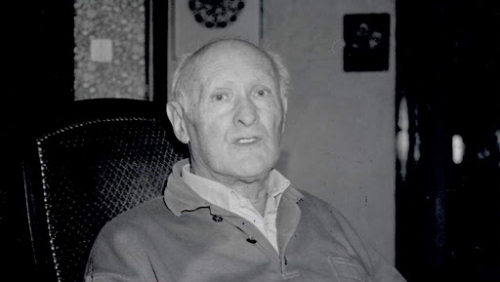
Notre ami Maurice Martin, ou Robert Dun, l’avait déjà compris il y a trente ans quand il disait : « Nous sommes à l’âge missionnaire qui doit suivre toute grande prophétie. Chacun de nous a le devoir de devenir missionnaire. Mais cela exige de se cultiver, de lire et de réfléchir beaucoup, de développer son élocution et ses capacités de discussion calme et efficace. Cela exige donc de connaître l’adversaire. C’est certes plus pénible que d’attendre l’apparition d’un problématique chef charismatique et même de vendre des journaux, de coller des affiches et de tenir des meetings. Prendre le pouvoir ? Qui peut espérer encore en avoir le temps ? »
Effectivement, nous n’avons plus le temps. Les hommes de ma génération et ceux de la génération qui l’a précédée après-guerre, ont tenté de faire reculer l’échéance inévitable de cette fin de cycle. Ils ont tenté de conserver intacts les principales facettes du génie européen, avec les moyens et l’esprit hérités du monde ancien, c’est-à-dire surtout le combat viril, celui qui est traditionnellement réservé à la deuxième fonction chez les Indo-européens, la fonction guerrière.
Ce sont souvent les mêmes qui ont constaté l’inanité du combat militant - on nous appelait « activistes » - et ce sont les mêmes qui ont ensuite privilégié le combat métapolitique, tout aussi infructueux. Nous n’étions pas très futés.
Il faut bien admettre que 60 ans de militantisme acharné ne nous ont pas permis d’accéder au pouvoir, ni politique, ni électoral, ni culturel. La gauche, les progressistes, les mondialistes règnent sur le continent européen comme jamais.
Paganisme : croyance ou savoir ?
Nous avons cependant eu le mérite de réveiller le tréfonds religieux de nos peuples européens, ce qui fut autrefois appelé le paganisme, à l’heure du christianisme naissant, expression destinée à humilier les forces vives paysannes de nos terroirs ; le temps a passé, les antiques valeurs européennes ont perduré ici et là à travers différentes manifestations sacrées, comme le cycle du Graal, puis, dans les années 1960, au sortir de la guerre d’Algérie, nous avons voulu établir d’autres fondements, nous avons espéré rebâtir la vieille charpente du paganisme préhistorique ; mais nous avons agi légèrement, sans bien comprendre les bases essentielles de ce passé spirituel que nous venions de redécouvrir et nous avons alors engendré une croyance hybride qui balançe entre un athéisme hédoniste et un animisme qui se contente timidement de la Voie des pères – la lignée - , pour assurer une continuité, sans faire l’effort de tenter d’accéder à la Voie des dieux, olympienne et transcendante, selon la distinction faite par Julius Evola qui disait : « avec l'avènement de l'humanisme et du prométhéisme, il a fallu choisir entre la liberté du souverain et celle du rebelle, et l'on a choisi la seconde[1]."
J’ai employé le mot « transcendante », ce qui veut dire extérieure et supérieure. Mais, nous, petits hommes de cette fin de cycle, nous ne croyons que ce que nous voyons ; d’un iceberg, on ne voit que le dixième ; d’une carotte en terre, on ne voit que les fanes, et si l’on considère l’horizon, on peut croire que la Terre est plate (c’est à la mode) alors que notre œil n’est capable de ne voir, et ne voit effectivement, qu’un infime arc de cercle qui ne paraît pas courbe du tout ; or, il l’est. L’homme se raccroche à la raison et à la matière, de peur de s’envoler vers d’autres mondes de peur de découvrir qu’il est plus que ce qu’il ne paraît. Je vous invite à méditer cette phrase d’un sage indou du Ve siècle : « « On ne peut pas dire qu’une chose n’existe pas parce que les sots ne la perçoivent pas » (Buddhaghosa)

Les monothéistes ne voient pas leur dieu, mais ils y croient ; les païens d’aujourd’hui voient leurs dieux, mais ils n’y croient pas. Pourtant, ils les voient tous les matins dans leur glace ; c’est Dieu qu’ils voient, sous les milliards de faces des milliards d’hommes vivants sur Terre. L’Homme est Dieu, une parcelle de Dieu plus ou moins grande, un être cosmique dont la stature grimpe jusqu’aux étoiles ou sur le dos de son voisin, selon son degré de sagesse et de connaissance ; c’est là la différence entre le paganisme originel et certains groupes néopaïens - et ces groupes-là foisonnent notamment dans la sphère New-Age ! - ; ces païens modernes ne peuvent être que de leur temps et de ce monde, soumis, dans le meilleur des cas, à la raison héritée des Grecs, d’une part, et à la matérialité, la force brute, héritée des Romains d’autre part ; nulle place pour la spiritualité des Celtes. Les universitaires historiens se sentiraient diminués s’ils avaient à consacrer ne serait-ce qu’un article à autre chose qu’à l’antiquité gréco-latine.
Bien qu’ils n’aient que le mot « sacré » à la bouche, ces gens refusent de franchir le pas vers le monde sacré, d’enjamber l’abime qui les sépare de cet autre monde ; parce que c’est aller vers l’inconnu dont ils ont peur et qu’ils sont bien trop impliqués dans leur monde bourgeois profane et son confort ; les vieux païens, dans des temps très anciens, savaient qu’ils côtoyaient leurs dieux ; ils les voyaient puisqu’ils étaient aussi présents dans chaque élément de la nature.
Nous ne devons pas parler, à propos des rapports avec le divin, de croyance ou de foi ; ces termes ne nous concernent pas ; Jung disait : « je ne crois pas, je sais. » ; nous devons parler de connaissance, qu’elle soit acquise par l’étude, ou par l’intuition, l’intuition qui n’est qu’une réminiscence des temps anciens, un souvenir blotti quelque part dans notre cœur et notre cerveau.
Dans cette volonté de rupture radicale avec le monde moribond qui nous entoure, il faut désormais se recentrer sur l’essentiel, la mission dont parlait Robert Dun, il faut rompre avec les vaines et vaniteuses dialectiques intellectuelles, il faut oublier les commentaires d’actualité qui n’auront plus d’intérêt le lendemain, il faut se garder de verser dans les intrigues et les machinations politiques… Toutes ces activités, si elles nous font plaisir, nous font perdre un temps précieux. Le monde qui vient a besoin de révolutionnaires, pas de réactionnaires, et encore moins d’intellectuels. Notre ami Guillaume Faye disait pertinemment, à ce sujet : « Alors que les barbares assiègent les murailles de Constantinople, on continue de disserter du sexe des anges et à faire de l’intellectualisme ».
Fin de cycle
J’ai parlé d’une fin de cycle ; Chroniques d’une fin de cycle, c’est le titre de mon dernier ouvrage ; mais il y a des fins de cycle qui n’ont rien de commun avec la Tradition.
Les écologistes, sous la férule d’Yves Cochet, inventent la « collapsologie », une sorte de fin du monde liée aux agressions subies par la planète
Certains économistes de « droite », « droite » avec des guillemets, se revendiquent « déclinistes » comme Nicolas Baverez.

Oswald Spengler, dans son Déclin de l’Occident, un prodigieux ouvrage paru en 1917, avait minutieusement analysé les causes historiques de ce déclin que nous constatons aujourd’hui et il en avait tiré le caractère cyclique des vies et des morts des civilisations. Il a écrit de splendides pages mais, il faut bien le dire, l’ensemble du Déclin de l’Occident, qui foisonne d’érudition, n’est pas accessible au plus grand nombre.
En ce qui nous concerne, nous tirons la connaissance de cette doctrine cyclique des anciennes traditions, celles qui ont constitué l’ossature initiale de la quasi-totalité des peuples de la planète et, spécialement, pour nous, en tant qu’indo-européens, de la Grèce protohistorique et de l’Inde ancienne.
Le symbole de l’ouroboros, le serpent qui se mord la queue, est répandu dans toutes ces antiques traditions, l’ouroboros, cet animal qui se nourrit de lui-même et qui renaît de lui-même, qui est donc le symbole du cycle, de l’infini, du retour aux sources, de l’éternel retour, dont le mythe a été évoqué, par Nietzsche ou Eliade. Ouroboros, quatre « o » dans le même mot pour bien signifier le cercle (du grec boros, manger, et oura, queue).
La Tradition primordiale
En amont de l’Histoire humaine, profane, nous sommes, nous, Européens, les héritiers de la civilisation primordiale, originelle, qui a apporté ses connaissances au monde, ce qu’on a nommé la Tradition primordiale, dont on situe le berceau géographique en une mythique Hyperborée, en Europe de l’extrême nord où le dieu grec Apollon effectuait ses visites annuelles à bord d’un char volant conduit par des cygnes blancs, selon la légende. C’est grâce à la Tradition primordiale qu’on peut comprendre pourquoi des pyramides ou des mégalithes sont disséminés de toutes parts à travers le monde alors que les civilisations qui les ont construits semblent n’avoir aucun lien entre elles.
Chronologiquement, nous nous situons à la fin d’un grand cycle de notre civilisation européenne qui renaîtra de ses cendres, si nous prenons la peine de rassembler les éléments positifs, ceux qui en ont constitué la grandeur. Les fins de cycles possèdent toutes les mêmes caractéristiques ; c’est une convergence de catastrophes naturelles et humaines qui ne laisse sur Terre qu’un infime échantillon de chaque règne : humain, animal, végétal, minéral, destiné à engendrer le cycle suivant. Et même le mythe biblique de l’Arche de Noé participe de cette vision. Il se fait que le cycle qui nous concerne est un grand cycle qui a duré, selon la Tradition, 64800 ans. Il y a eu, dans l’Histoire sacrée, c’est-à-dire la préhistoire, l’Histoire antérieure à l’Histoire profane des historiens et des archéologues officiels, il y a eu plusieurs grands cycles, et des centaines de petits cycles contenus dans les grands cycles. Je ne vais pas m’attarder sur ce point précis, je l’ai déjà souvent développé.

Avant de poursuivre, je vais citer une phrase de René Guénon qui correspond assez bien à la situation actuelle ; il dit : « Les événements à venir ne pourront pas être compris par la généralité, mais seulement par le petit nombre de ceux qui seront destinés à préparer, dans une mesure ou dans une autre, les germes du cycle futur. Il est à peine besoin de dire que, dans tout ce que nous exposons, c’est à ces derniers que nous avons toujours entendu nous adresser exclusivement, sans nous préoccuper de l’inévitable incompréhension des autres. »
« Tradition primordiale » : On comprend facilement le sens du mot « primordiale » dans l’expression Tradition primordiale : c’est ce qui est à l’origine de tout. On comprend moins le sens du mot Tradition, un mot galvaudé, utilisé à toutes les sauces. La Tradition n’est pas le passé ; elle ne passe pas, elle reste ; sa principale caractéristique est d’être pérenne ; quand nous terminons un cycle, nous ne retournons pas vers le passé, mais nous remontons vers la source, c’est-à-dire vers notre naissance, vers notre re-naissance. J’ai pris tout à l’heure l’exemple de l’ouroboros, je peux prendre aussi l’exemple de la roue pour bien faire comprendre ce qu’est la Tradition primordiale.
La roue
Dans une roue, le moyeu est immobile, c’est le centre, là où se tient lové le dieu qui fait tourner la roue ; le moyeu représente la pérennité, ce qui est immuable, permanent, éternel ; c’est un principe comme l’était, par exemple autrefois, le principe monarchique ; tout s’agite et tourne autour du moyeu, le dieu-roi fait tourner le monde, les cycles se succèdent. Au moyeu se tient le principe spirituel. Plus on s’éloigne du centre, du moyeu, du pôle, plus on descend vers le cercle extérieur, en contact direct, dur et bruyant avec le sol, plus on descend vers ce cercle, plus on entre dans la matérialité ; les rayons constituent le moyen de dégringoler vers la matérialité ou, à l’inverse, en sens contraire, de monter vers le divin, vers le centre spirituel, vers l’origine, pour se régénérer, se ressourcer, retourner à la source et renaître à nouveau.
Vous aurez tous compris qu’il est bien plus difficile de remonter que de descendre. Julius Evola voyait justement la mode du ski alpin comme un symbole de cette négation de l’effort ; à ski, on ne fait que descendre, et on utilise ensuite des remontées mécaniques pour… recommencer à descendre.
Nous allons nous intéresser à ce monde que fait tourner autour de lui le dieu qui veille dans son moyeu.
Le système cyclique
La cyclologie, le système cyclique, n’est pas un concept utopique ; ce n’est pas non plus le résultat de supputations intellectuelles mûrement élaborées ; le système cyclique est le fondement même de la marche concrète du monde, du cosmos ; rappelons que le mot cosmos lui-même signifie « ordre » en grec. Tout ce qui vit sur Terre est soumis à l’ordre cosmique et à son fonctionnement qui est cyclique dans toutes ses manifestations.
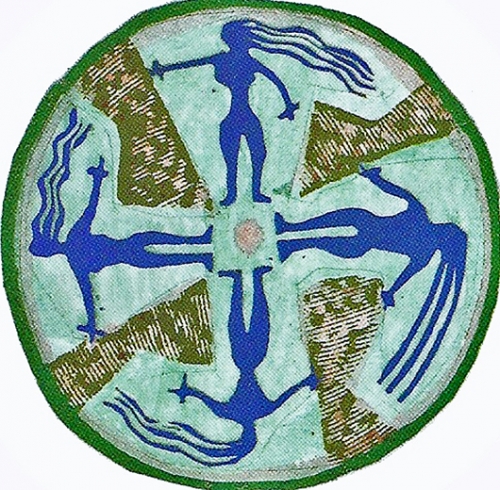
C’est une constatation d’ordre pratique qui ne laisse aucune place à l’approximation, aux digressions ou à l’émission d’autres hypothèses, la nature est ainsi faite, que ça plaise ou non.
Justement, ça ne plaît pas à tous.
Les monothéismes ont inventé la linéarité : un début, une fin. C’est un concept tout à fait artificiel conçu par l’Homme. Le dogme darwinien constitue un quatrième monothéisme, scientiste cette fois, dans cette perspective linéaire. Nous sommes issus, d’après ce concept, d’un singe et, après quelques millions d’années, nous avons appris à nous servir d’une massue pour fracasser le crâne des animaux et nous avons appris à cueillir des baies et des fruits pour nous nourrir puis il nous a fallu quelques millions d’années encore pour planter quelque chose et élever du bétail, et ainsi de suite jusqu’au siècle dernier où, en quelques années, nous avons peut-être marché sur la lune… Enfin, peut-être.
Evola dit que de l’inférieur ne peut naître le supérieur. Et il dit encore « Pour être précis, il est à nos yeux plus juste de dire que le singe dérive de l’homme par involution que d’affirmer que l’homme dérive du singe par évolution. Comme pour de Maistre, pour nous aussi, les peuples sauvages ne sont pas des peuples primitifs, au sens de peuples originels, mais souvent des restes dégénérés, crépusculaires, nocturnes, de races plus anciennes qui ont entièrement disparu. »
La linéarité suppose une évolution ; l’évolution a créé le dogme du « progrès ». Le progrès n’existe pas, autre que technique, on peut constater qu'il n'y a pas de progrès spirituel, tout le monde continuant à s'écharper de plus belle mais les progressistes, eux, persistent à exister ; ils ont échappé à tous les massacres, hélas.
C’est en observant le mouvement cyclique des planètes que nos ancêtres ont établi une mesure du temps ; les arbres, les fleurs, les saisons, les calendriers : heures, jours, mois, années, les civilisations, les peuples, meurent et renaissent suivant un processus bien ordonné, même s’il paraît aléatoire, de la même façon que le mouvement des planètes est réglé suivant un laps de temps précis mais pas toujours égal, ce que nous avons quelquefois du mal à comprendre, car si le mouvement cyclique consistait en un cercle fermé, ce serait plus simple ; mais le cercle fermé n’offre pas d’avenir autre que similaire à tout ce qui a été ; or, nous voyons bien que l’Histoire n’est pas exactement pareille même si ses épisodes se ressemblent étrangement. De même, les astres ne tournent pas en suivant un cercle bien formé mais selon une figure spiralée – notre galaxie est une spirale – de la même façon que notre planète n’est pas une sphère parfaite mais une figure ellipsoïde. C’est dans cette différence que tient le mouvement, quelquefois légèrement décalé, et ce mouvement, imparfait dans sa rotation, c’est la vie. Le système cyclique n’est pas un système qui suppose que notre destin est tracé une fois pour toutes. Il laisse, en spirale ouverte, une part à l’inconnu. C’est la part qui est destinée à l’âme européenne, celle des dieux.
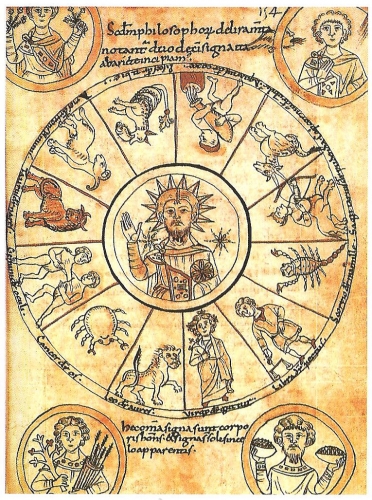
La réincarnation
J’ai parlé des civilisations et aussi des peuples dont la vie est réglée de manière cyclique ; je n’ai pas parlé des vies humaines, individuelles ; il s’agit là du concept de réincarnation ; le concept de réincarnation suit aussi un processus cyclique, mais, cette fois, en évolution ; les scientifiques profanes appellent « entropie » la loi de dégradation de l’énergie qui conduit à l’énergie zéro, c’est-à-dire à la mort. Lorsque cette loi s’inverse, on parle d’entropie négative, dans ce cas, le temps ne dégrade plus mais, au contraire, il construit (ce qui, d’ailleurs, n’a rien de négatif, ce serait même positif, allez comprendre le langage des modernes !). En gros, tout ce qui est de l’ordre de la matière sur Terre, tout ce qui concerne le profane, est en involution, et tout ce qui est de l’ordre du spirituel, du sacré, dans le cosmos, est en évolution. Nous avons vu ce processus double à propos de la roue, où l’individu monte ou descend les rayons selon sa qualité ou son absence de qualité, sa paresse ou sa volonté.
Selon le concept de réincarnation, cette doctrine soutenue par les Grecs, notamment par Pythagore et Platon, la Terre est une sorte d’école où les âmes individuelles vivent, meurent et renaissent dans des corps différents tout au long d’une longue vie qui peut se compter en milliers d’années terrestres ; chaque vie doit amener l’âme à devenir meilleure que dans la vie précédente ; l’âme choisit avant de revenir sur Terre le cadre dans lequel elle va vivre sa nouvelle vie, elle choisit donc aussi les parents et la famille, qui vont l’aider pour ce projet ; selon les traditions, notamment indoues, ceux qui se sont comportés comme des êtres nocifs au cours d’une vie doivent payer leur malfaisance et leurs turpitudes dans la vie suivante ; ils revivent donc, cette fois sans avoir le choix, dans les plus tristes conditions : infirmes sur le plan physique ou mental, mal dans leur peau, de quelque couleur qu’elle soit, ou de quelque sexe indéfini qu’elle soit, ces gens sont aussi dédiés à vivre une vie misérable dans des pays miséreux avec des gens qui leur ressemblent, dans des conditions de travail, de santé, d’hygiène, de moeurs épouvantables ; l’ensemble de ces conditions dégradantes s’appelle le karma chez les Hindous ; chez les Européens, ces gens constituent ceux qu’on appelle aujourd’hui les « minorités », tous ces individus décalés qui osent en plus revendiquer un statut au moins égal à ceux qui se sont toujours bien comportés ; il n’y a pas de quoi s’apitoyer sur le sort de ces individus qui tentent de culpabiliser l’Homme blanc et l’Européen avant tout, même s’ils sont eux-mêmes blancs et Européens.
Les forces négatives désormais à la tête de l’ordre mondial manipulent cette masse de disgraciés contre les gens normaux pour qu’elle instaure la « dictature des minorités » en remplacement des structures anciennes existantes ; cette horde de déshérités aux faibles immunités sera à son tour balayée dès la destruction accomplie de l’ancien monde.
Ne nous trompons pas sur l’aspect : Les âmes matérialistes et rationalistes sont de jeunes âmes, des enfants qui apprennent à marcher mais qui ne voient pas plus loin que le bout de leur nez ; je rappelle que, en vertu de l’inversion des valeurs en fin de cycle, ce sont ces gens qui tiennent illégitimement le haut du pavé ; la sagesse n’est pas une question d’âge ; il n’y a aucune raison pour des personnes saines d’être impressionnées par le vieux sénateur bedonnant, bouffi d’orgueil et d’assurance, qui connaît toutes les ficelles pour « faire du fric » ; c’était l’expression employé par Sarkozy quand on lui demandait quels étaient ses projets après avoir perdu l’élection présidentielle.
Selon certaines sources, des personnes ayant souhaité revivre des vies antérieures ont pu le faire sous la conduite d’un hypnotiseur ; selon ces témoignages, certaines d’entre elles ont pu retrouver la maison toujours existante qui a abrité une de leurs précédentes vies, en reconnaissant les lieux avec précision.
La montre
Je vous ai jusqu’à présent exposé ce qui semble être des théories ; Nous allons maintenant entrer dans le concret avec un exemple très simple et accessible à tout le monde.
Regardez votre montre avec ses trois aiguilles qui tournent à une vitesse différente ; ces aiguilles sont généralement pourvues d’une flèche à leur extrémité. Elles sont triomphantes et pleines de santé quand elles pointent en haut sur le midi, mais elles ont la tête en bas quand elles se rejoignent sur le 6, formant ainsi le nombre 666. A ce moment précis, toutes les valeurs qui régissaient une vie ordonnée cosmiquement sont inversées ; c’est l’Apocalypse, la fin d’un monde, mais c’est aussi la Révélation et l’annonce d’un monde nouveau puisque, lorsque tout espoir est perdu et que la situation est devenue catastrophique et cataclysmique, les aiguilles ne s’arrêtent pas et entament leur remontée vers le midi ; il faut que la dissolution de toute forme positive qui subsistait encore soit accomplie pour que les aiguilles puissent symboliser le basculement vers l’Age d’Or, vers le Grand Midi.
Dans la roue qui indique la succession des quatre Ages, on passe directement de l’Age de fer (l’Age du loup, selon les nordiques) ou l’Age sombre, à l’Age d’Or.
L’instant précis où les trois aiguilles se chevauchent sur le 6 marque une conjonction, celle d’un grand cycle.

Ceux qui possèdent une montre où tous les rouages sont visibles constatent que plusieurs roues dentées de diamètres différents tournent à des vitesses également différentes et se rejoignent donc à un moment pour déterminer cette conjonction. La montre est le reflet du monde en mouvement avec des civilisations différentes qui ne vivent pas au même rythme mais qui finissent par se rejoindre à un moment pour entamer un nouveau cycle général.
Nous en sommes là, à ce moment précis que certains d’entre vous qui m’écoutez auront à la fois la chance et le malheur de vivre.
Les quatre âges
Cet exemple de la montre avec ses engrenages va nous aider à comprendre les différentes durées de cycles qui s’emboîtent les uns les autres comme des poupées russes.
Je le disais : ce sont principalement les Indous et les Grecs qui ont élaboré cette science sacrée qu’on appelle la cyclologie. Nous allons voir que tous les nombres édictés par ces deux grandes cultures ont une répercussion exacte sur la vie de la nature et la vie des hommes, ces deux vies étant inséparables.
L’indianiste Alain Daniélou nous parle d’humanités qui se succèdent, donc qui disparaissent et renaissent et non pas de civilisations dont les durées de vie sont subordonnées à celle de chacune de ces humanités. On peut être surpris par le fait que la tradition shivaïte situe le début du Kali Yuga de notre Humanité, c’est-à-dire le début de la fin de notre cycle, à environ 5000 ans en arrière. Si l’on considère que nous sommes vraiment arrivés au bout du bout de ce grand cycle, déterminé par l’âge de fer, autrement dit le Kali-Yuga, notre déclin aurait commencé vers moins 4460.
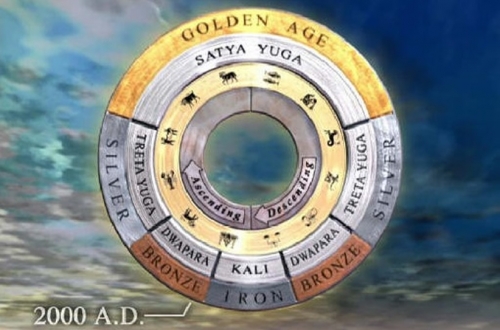
Cette tradition situe même avec précision le début de la fin de ce même Kali-Yuga en 1939, date qui marque une fracture de l’histoire. Les Hindous, tout comme Hésiode, poète grec du VIIIe siècle avant notre ère, distinguent quatre âges pour chaque cycle ; ces quatre âges ont des périodes de vie calculées sur la base proportionnelle 4, 3, 2, 1. L’Age d’or, fort heureusement, est le plus long, et l’Age de fer le moins long ; il existe plusieurs façons de calculer ces âges, selon qu’il s’agit d’un petit cycle ou d’un grand cycle mais les valeurs de base sont toujours les mêmes.
À l’Âge d’or cité par Hésiode correspond, chez les Indous, le Krita Yuga.
À l’Âge d’argent correspond le Treta Yuga.
À l’Âge d’airain, ou de bronze, correspond le Dvapara Yuga.
À l’Âge de fer correspond le Kali Yuga.
Sans entrer dans le détail, je fais remarquer qu’il y a là une hiérarchie des métaux, à partir de l’or, qui est incorruptible et brillant comme le soleil, jusqu’au fer qui se dégrade en rouille pour finir par disparaître totalement.
Mircea Eliade nous dit qu’on « peut calculer de différentes manières la durée relative de chacun de ces quatre yugas ; tout dépend de la valeur qu’on accorde aux années, c’est-à-dire si on a affaire à des années humaines ou à des années « divines » dont chacune comprend 360 ans[2]. »
Revenons aux Yugas ; René Guénon est précis : « évaluées en années ordinaires, ces mêmes durées des quatre yugas seront respectivement de 25920, 19440, 12960, et 6480 ans, formant le total de 64800 ans[3]. » Remarquons que le kali-yuga constitue le dixième du siècle.
Un grand cycle présente une particularité, une « coïncidence », la conjonction (ou la convergence selon le terme employé par Guillaume Faye), la conjonction de plusieurs fins, de la même façon qu’il existe en astrologie des conjonctions extraordinaires ou, tout simplement, des éclipses. Le temps des hommes et celui de la Tradition, ou des dieux, se rejoignent. Le crépuscule du Kali-Yuga coïncide avec la fin d’un christianisme deux fois millénaires mais à bout de souffle, et avec le déclin de l’Occident emporté par la même vague puisqu’il avait identifié son Histoire à celle du christianisme. Les membres des sectes chrétiennes millénaristes espèrent une « apocalypse » - mot pris ici dans le sens de « fin du monde », et non pas de « révélation » - une fin du monde qui verra leur accession au ciel, près du trône de Dieu. Cette conjonction oppose deux vues-du-monde complètement différentes, l’une cosmique pour qui le crépuscule du Kali-Yuga ne représente que la fin d’un cycle et le début d’un nouveau, l’autre chrétienne, qui ne peut envisager d’autre fin que totale, et définitive.
25920, le nombre cosmique
Je vais maintenant vous parler d’un nombre important : le 25920.
Ce nombre est déjà apparu dans la conférence : c’est le temps que dure l’Age d’or en petit cycle. Un nombre qu’on peut au moins prononcer. Ça n’est pas étonnant, c’est un nombre humain. Faisons le calcul d’une journée, mais, cette fois, pour faire un mois : 60 secondes x 60 minutes = 3600 x 24 heures = 86400 secondes. En un mois, moyenne de 30 jours : 86400 x 30 = 2 592 000 secondes.
On pourrait penser qu’il s’agit d’un hasard si je donne un autre calcul à faire : la vitesse de la lumière est de 300 000 km par seconde, comme il y a 86400 secondes en un jour, la lumière parcourt donc 25920 millions de kilomètres par jour.
Encore une coïncidence ? La vitesse de la Terre autour du Soleil est de 30 km par seconde. Elle couvre donc 2 592 000 km par jour.
La Terre tourne sur elle-même et elle tourne autour du Soleil, mais un troisième mouvement l’anime, ce mouvement est connu par l’expression « précession des équinoxes ». Le très ancien laboratoire astronomique de Stonehenge, constitué de mégalithes dressés selon un ordre bien précis, avait parfaitement défini et prévu ce mouvement dans ses phases ultérieures quelques milliers d’années avant les calculs effectués par ordinateur. L’axe de la terre n’est pas fixe, il tourne lui-même selon un mouvement qu’on pourrait comparer à celui d’une toupie en bout de course ; le mouvement du pôle terrestre est cependant régulier et ne va pas s’arrêter, du moins pas avant quelques milliards d’années.
Ce mouvement met…, vous l’avez deviné, 25920 ans pour dessiner une révolution complète.
Ce nombre cosmique est pleinement analogique et prouve que l’Homme est un être cosmique, si l’on considère que le nombre moyen de respirations de l’être humain est de 18 par minute, soit, pour une journée : 25920.
Les ères zodiacales
Sur le plan zodiacal, nous allons entrer dans l’ère du Verseau, qui succède à celle des Poissons. Chacune de ces ères compte 2160 années ; on définit approximativement l’ère des Poissons comme ayant commencé avec la naissance du Christ, voire quelques dizaines d’années auparavant avec la naissance de Mithra dont le Christ est une sorte de calque. La totalité du cycle zodiacal compte 12 ères de 2160 années chacune, soit… 25920 ans.
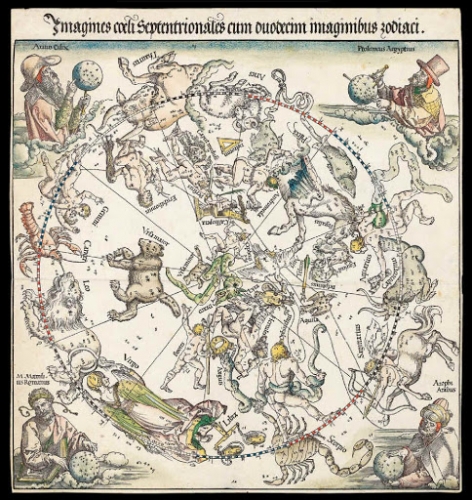
Je rappelle, par ailleurs, que le kali-yuga, notre fin de cycle, englobe trois ères zodiacales, qui sont, à mesure de leur apparition, de plus en plus marquées par la dégradation des valeurs originelles européennes, la dernière représentée par le christianisme, l’ère des Poissons, et, actuellement, par un pape dévoyé qui renie toutes les valeurs qui ont eu cours en Europe pendant 2000 ans, même celles revendiquées par les chrétiens. Inutile de parler du dernier avatar monothéiste qu’est l’islam, vous savez ce qu’il faut en penser.
Le nombre d’or
Un dernier exemple qui prouve de façon incontestable que la nature, et donc le principe divin, avait bien tout prévu. C’est le nombre d’or, 1.618, la divine proportion, divine proportion parce que toutes les mesures harmonieuses du corps humain sont régies par la loi du nombre d’or et que c’est aussi le cas dans la nature pour d’innombrables espèces animales ou végétales ; là encore, le seul mérite de l’Homme est d’avoir découvert ce qui existait déjà. Les plus grands peintres comme Dürer ou Da Vinci et les plus grands architectes comme les constructeurs des abbayes cisterciennes ont fondé leurs oeuvres sur le principe du nombre d’or ; il se retrouve même dans la construction de certains dolmens, comme celui du Goërem à Gâvres dans le Morbihan (daté de – 5000 ans). C’est le symbole, et le secret, de tout ce qui est harmonieux sur Terre. Dans la nature, les exemples sont nombreux, depuis l’ammonite de plus de 100 millions d’années jusqu’aux coquilles d’escargot, les tournesols ou les coeurs de chardon.
L’involution contre le progressisme
Tous ces chiffres que je vous assène ont leur importance ; nous nous situons sur le terrain même de l’ennemi : les chiffres, les nombres, le règne de la quantité ; eh bien, sur ce terrain-là, leur propre terrain, ils ont tort ; ces nombres prouvent que le progressisme est une escroquerie.
Les esprits sont formatés par l’utopie de l’évolution et du progrès depuis au moins 2000 ans. Dire ce que je dis équivaut à faire du révisionnisme spirituel.
Et, pourtant, ces références chiffrées du système cyclique sont tout à fait claires et en conformité avec la science profane, ou moderne, comme vous voulez, qui ne reconnaît que ce qui est statistiquement reproductible.
La doctrine cyclique nous vient du fond des âges ; nous allons voir qu’elle est le plus sûr moyen de contrer l’idéologie progressiste qui est une supercherie, car les cycles naturels terrestres procèdent concrètement de l’involution, exact contraire de l’évolution ou du progrès.
C’est le principal, et définitif, argument que nous avons pour contrer l’utopie progressiste.
Ainsi, de notre vie humaine : les progressistes peuvent-ils aller contre la constatation que, dès que le bébé pousse ses premiers vagissements lui répondent les derniers râles d’agonie de l’homme mourant ? Que, dès nos premiers instants de vie, nous sommes condamnés à la mort. Est-ce ça qu’ils appellent une évolution ou un progrès ? Est-ce ça qu’ils appellent « aller de l’avant », une de leurs expressions favorites ?
Autre exemple :la nuit la plus courte de l’année, au solstice d’été, marque, dès le lendemain, le début d’une régression : les jours commencent à rallonger et, déjà, l’hiver pointe son nez alors que l’été n’est pas encore commencé ; est-ce là un progrès, une évolution ?
Dernier exemple : dès qu’un jour commence, il va vers sa fin pour être remplacé par la nuit, et inversement.
Le concept de modernité
Il est ancré dans les esprits que plus un concept est récent et plus il a de qualités parce qu’il serait le fruit de la modernité. Et les snobs (vous le savez sans doute, mot qui signifie sine nobilate : sans noblesse) de se pâmer devant telle sculpture ancienne aux lignes épurées parce qu’elle est tellement pleine de modernité, comme si l’étalon du beau était définitivement celui de l’art contemporain, de notre époque ; Or, c’est le contraire : plus un concept est récent, et plus il est le résultat, l’incarnation, de la dégradation du cycle, plus il est porteur des miasmes délétères de la fin. Plus quelque chose est nouvelle dans le cycle finissant et plus elle est marquée par une déchéance et une décomposition. Le « nouveau monde » est donc plus vicié que l’ancien, l’Amérique plus décadente que l’Europe ; plus nous allons vers le futur et l’avenir, et plus nous régressons, plus nous nous rapprochons de notre mort, de notre fin. Mais, je le répète, l’involution ne concerne que le monde profane ou moderne.
Christophe Levalois écrivait en août 2000, dans la revue Roquefavour : « Il importe en premier lieu de cerner ce que nous entendons par modernité. Pour nous, ce terme n’est pas synonyme de monde actuel ou encore de présent. La modernité est une vision du monde, une manière d’être et d’agir, qui engendre un type de société. Elle domine sans partage aujourd’hui. Sa caractéristique principale est un refus et un éloignement de l’Esprit (qu’on l’appelle Un, comme Plotin, Dieu, ou encore les Olympiens). La transcendance est non seulement niée, mais totalement incomprise.
Le moderne ignore ce qu’il ne perçoit pas en raison de son incrédulité et, il faut bien le dire, de l’atrophie de certaines de ses perceptions devenues extrêmement grossières et déséquilibrées.
Il a perdu le sens du surnaturel, lequel n’a aucun rapport avec l’irrationnel ou des troubles psychologiques dans lesquels les rejettent les modernes. L’irrationnel est le corollaire du rationnel. Le surnaturel n’est pas une déviance de notre réalité, mais une réalité tout aussi concrète que celle que nous connaissons au quotidien. »
A dire vrai, c’est l’Homme moderne qui présente des insuffisances par rapport à un être différencié ayant conservé l’essentiel de ses facultés de raisonnement. L’être « différencié » ne l’est que par rapport à la dégradation des facultés naturelles de la quasi-totalité des humains qui l’entourent.
Les hommes et les femmes qui vont relancer la roue du nouveau cycle ne feront plus partie du monde profane.
L’être différencié, nous allons en parler pour finir cette conférence ; c’est le volet qui nous concerne tous et fondamentalement.

L’Homme cosmique
Notre mission ? Celle dont parlait Robert Dun ?
Déjà bien définir l’ennemi.
D’abord, les mondialistes, quelques hyper-riches qui tiennent la planète sous leur joug, puis leurs laquais qui gouvernent nos pays, puis les masses de progressistes qui les soutiennent, puis les tas de bourgeois apeurés et résignés à se laisser massacrer, grand troupeau de moutons qui se laisse docilement mener à l’abattoir ; puis les hédonistes, après, les minorités dégénérées dont j’ai parlé plus haut, et aussi, dans l’urgence, les islamistes.
Dans l’urgence, nous sommes pris en tenaille d’une part entre les hordes de zombies qu’on appelle de nos jours les « minorités visibles » (et elles font tout pour l’être, Vous n’avez qu’à regarder la vidéo d’une gay pride ou d’un défilé de mode) et, d’autre part, l’autre arme de l’Ordre mondial : les fanatiques islamistes instrumentalisés eux aussi par les entités sataniques qui dirigent le monde. Ces sauvages bourrés de Captagon, sorte de meute déchaînée et hallucinée, sans foi ni loi, comme les orques dans « Le Seigneur des anneaux », vont se répandre comme les barbares à la fin de l’empire romain, dans nos pays européens – et ils ont déjà bien entamé leur mission - dans une apocalypse de feu et le sang. Ce sont ces derniers qui vont s’en prendre d’abord aux LGBT et autres invertis. On peut prévoir que nombre d’homosexuels, hommes et femmes, seront précipités du haut de la tour Eiffel ; puis ils massacreront les masses progressistes ou apathiques avant d’être eux-mêmes exterminés par les milices de l’Ordre mondial. N’oublions pas que l’islam, comme les deux autres religions du livre est en décadence ; les mondialistes – Satan – l’utilisent comme un cheval de Troie pour arriver à leur fin ; l’islam signifiant « soumission », rien ne peut mieux convenir aux élites mondialistes ; le comportement des musulmans va aider les mondialistes qui vont tout faire pour que les musulmans remplacent les Européens. Quand nos gouvernants ne répondent pas à l’invasion, c’est que c’est eux qui l’organisent, il ne s’agit ni de suicide, ni d’imprévision, ni de naïveté.
Le but de nos ennemis, c’est d’atteindre le moyeu de la roue pour arrêter cette dernière et empêcher le démarrage du nouveau cycle. Les transhumanistes veulent remplacer Dieu ; Mircea Eliade écrit dans « Le sacré et le profane » : S’il est vrai que notre monde est un cosmos, toute attaque extérieure menace de le transformer en « Chaos »
Julius Evola appelle « l’être différencié » un certain type de personne qui a renoncé à s’impliquer dans ce monde ; c’est un concept élaboré dans son ouvrage Chevaucher le tigre, un titre qui signifie qu’il convient de vivre dans ce monde tout en n’étant pas dupe du conditionnement cérébral qu’il nous impose.
L’Homme cosmique
Il y a eu les veilleurs qui nous ont aidé à arriver jusqu’à la fin ; maintenant, c’est aux hommes différenciés de prendre le relais : les sages occupant la première fonction vont rassembler les bagages ; une chevalerie va naître pour la deuxième fonction, les producteurs vont nous aider à vivre en autarcie.
Cette chevalerie devra naître sur la base du principe aristocratique, le gouvernement des meilleurs. Ceux qui sont capables de se donner des règles et maintenir pour eux-mêmes et pour les autres un comportement sans taches, impeccable, mot qui signifie sans faute, ou sans péché.
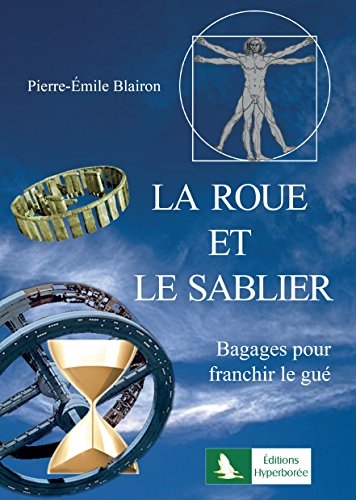 La mission des êtres différenciés est triple : elle consiste d’abord à se protéger, à survivre pour faire repartir le nouveau cycle ; inutile de s’investir dans la mêlée ; laissons-les s’entretuer. Le deuxième volet de cette mission consiste à rassembler les bagages pour franchir le gué, c’est le sous-titre de mon livre : La Roue et le sablier ; cette mission consiste à réunir tout ce qui a fait la grandeur de l’Europe. Enfin, le troisième volet consiste, par notre seule présence et notre seule volonté, comme une sorte d’égrégore, à empêcher nos ennemis d’arrêter le mouvement de la roue et la naissance du nouveau cycle.
La mission des êtres différenciés est triple : elle consiste d’abord à se protéger, à survivre pour faire repartir le nouveau cycle ; inutile de s’investir dans la mêlée ; laissons-les s’entretuer. Le deuxième volet de cette mission consiste à rassembler les bagages pour franchir le gué, c’est le sous-titre de mon livre : La Roue et le sablier ; cette mission consiste à réunir tout ce qui a fait la grandeur de l’Europe. Enfin, le troisième volet consiste, par notre seule présence et notre seule volonté, comme une sorte d’égrégore, à empêcher nos ennemis d’arrêter le mouvement de la roue et la naissance du nouveau cycle.
Concrètement, mais je ne suis pas le mieux placé pour en parler, je suggère que se créent des structures solidaires disséminées – ce ne sont pas inévitablement des regroupements communautaires physiquement installés qui pourraient être trop facilement ciblées par nos ennemis ; je suggère que ces structures solidaires agissent sur le principe du localisme, un mot nouveau pour faire revivre ce qui était la base de nos sociétés indo-européennes ; je suggère que, au sein de chacune de ces structures soit désigné un représentant de chacune des anciennes fonctions indo-européennes : la fonction sacerdotale et royale qui est celle des constructeurs ; la fonction guerrière, celle qui protège les frontière du territoire qui accueille le clan, qui protège ses biens et les membres du clan, c’est celle des protecteurs, la fonction qui assure les besoins vitaux d’une communauté, celle des producteurs. Ces triumvirats seront en contact et en échanges permanents avec les autres triumvirats de chacune des communautés.
J’espère que cette conférence aura servi à quelque chose. Merci de m’avoir écouté.
Notes:
[2] Mircéa Eliade, Images et symboles, Gallimard
[3] René Guénon, Formes traditionnelles et cycles cosmiques, Gallimard
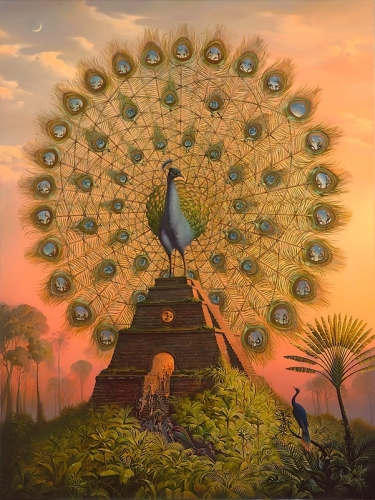



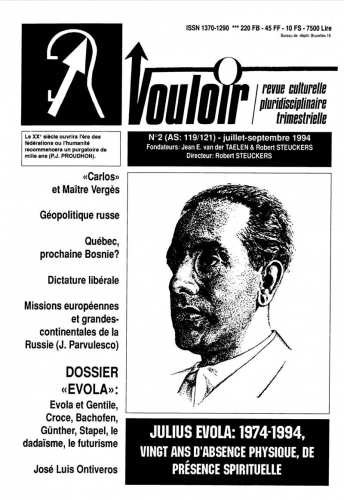
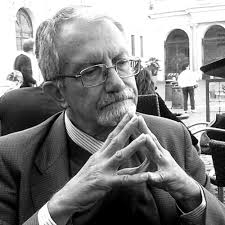
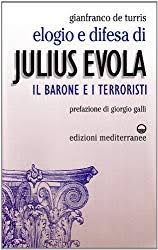 We will surely remember 1994 better than 1984, which Orwell immortalised by writing his celebrated apocalyptic book predicting an ultra-totalitarian world in which we all would have been irredeemably crushed. We will not remember it solely for the political event of 27 March in Italy, but above all for the consequences that this “reversal” might (I insist on the conditional!) have in the cultural sphere. Whatever one may thing of the victory of Berlusconi and his allies, it has already had a first result: the organisation of a colloquium dedicated to the personality of Giovanni Gentile; it was held in Rome on 20 and 21 May 1994 on the initiative of the leftist municipal council (which does honour to the Italian left, as does the other colloquium it dedicated to Nietzsche). We remember he whom we always defined as the “philosopher of Fascism,” fifty years after his death, when he was assassinated by a commando of communist partisans in Florence on 15 April 1944. After having beaten a long and sinuous intellectual course, many post-Marxist philosophers, such as Colletti, Marramao and Cacciari, claimed him for an authentic figure of the left, at least in a decent part of his work.
We will surely remember 1994 better than 1984, which Orwell immortalised by writing his celebrated apocalyptic book predicting an ultra-totalitarian world in which we all would have been irredeemably crushed. We will not remember it solely for the political event of 27 March in Italy, but above all for the consequences that this “reversal” might (I insist on the conditional!) have in the cultural sphere. Whatever one may thing of the victory of Berlusconi and his allies, it has already had a first result: the organisation of a colloquium dedicated to the personality of Giovanni Gentile; it was held in Rome on 20 and 21 May 1994 on the initiative of the leftist municipal council (which does honour to the Italian left, as does the other colloquium it dedicated to Nietzsche). We remember he whom we always defined as the “philosopher of Fascism,” fifty years after his death, when he was assassinated by a commando of communist partisans in Florence on 15 April 1944. After having beaten a long and sinuous intellectual course, many post-Marxist philosophers, such as Colletti, Marramao and Cacciari, claimed him for an authentic figure of the left, at least in a decent part of his work.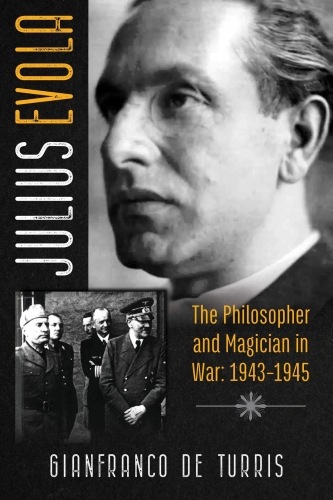
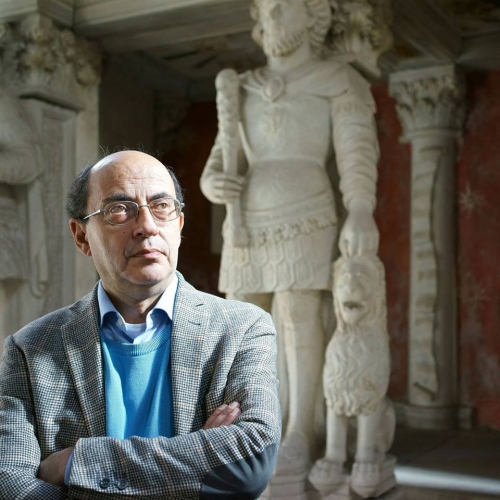
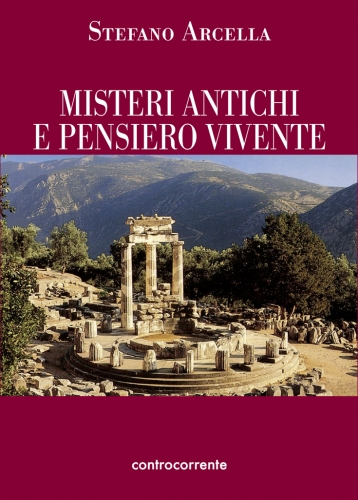
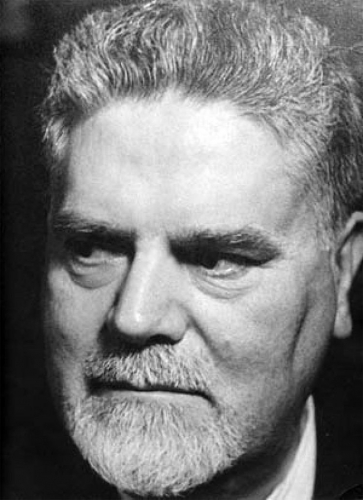
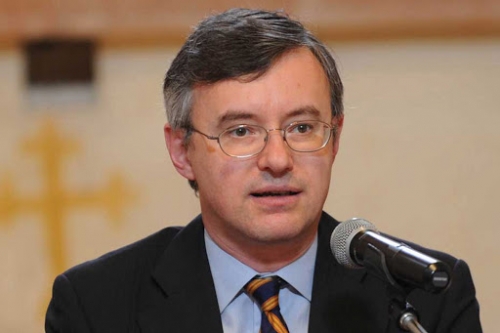
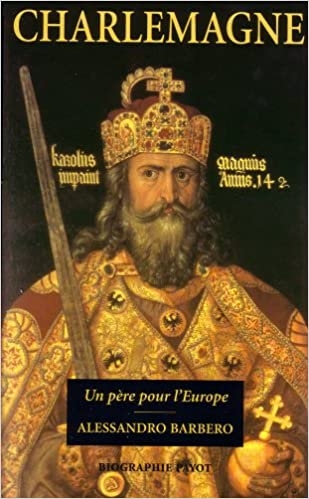
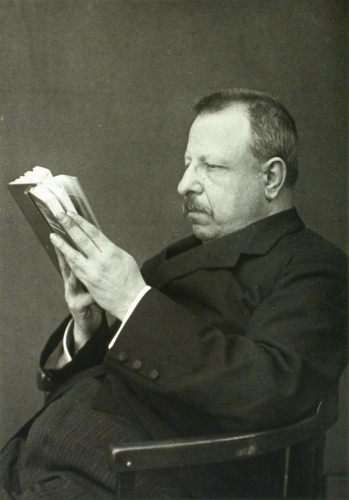

 del.icio.us
del.icio.us
 Digg
Digg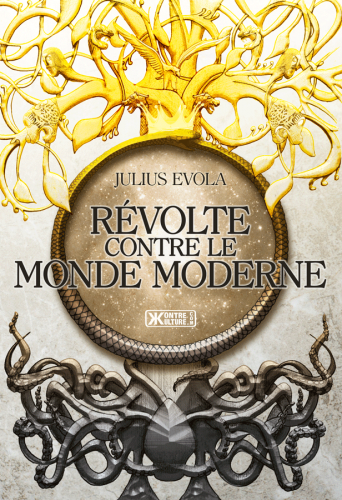











 La mission des êtres différenciés est triple : elle consiste d’abord à se protéger, à survivre pour faire repartir le nouveau cycle ; inutile de s’investir dans la mêlée ; laissons-les s’entretuer. Le deuxième volet de cette mission consiste à rassembler les bagages pour franchir le gué, c’est le sous-titre de mon livre : La Roue et le sablier ; cette mission consiste à réunir tout ce qui a fait la grandeur de l’Europe. Enfin, le troisième volet consiste, par notre seule présence et notre seule volonté, comme une sorte d’égrégore, à empêcher nos ennemis d’arrêter le mouvement de la roue et la naissance du nouveau cycle.
La mission des êtres différenciés est triple : elle consiste d’abord à se protéger, à survivre pour faire repartir le nouveau cycle ; inutile de s’investir dans la mêlée ; laissons-les s’entretuer. Le deuxième volet de cette mission consiste à rassembler les bagages pour franchir le gué, c’est le sous-titre de mon livre : La Roue et le sablier ; cette mission consiste à réunir tout ce qui a fait la grandeur de l’Europe. Enfin, le troisième volet consiste, par notre seule présence et notre seule volonté, comme une sorte d’égrégore, à empêcher nos ennemis d’arrêter le mouvement de la roue et la naissance du nouveau cycle.
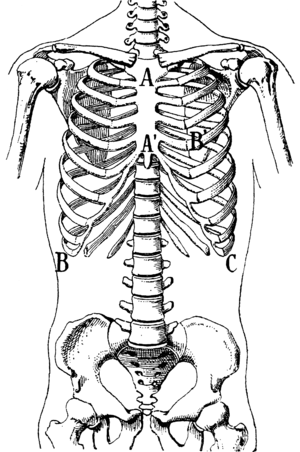
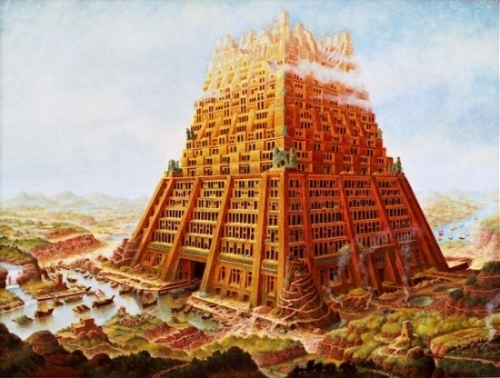
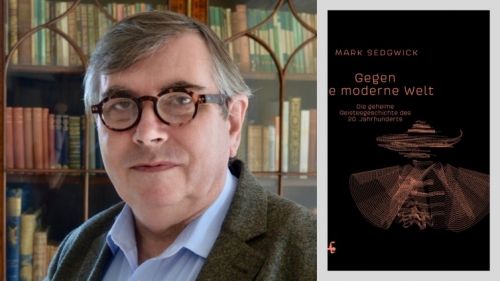
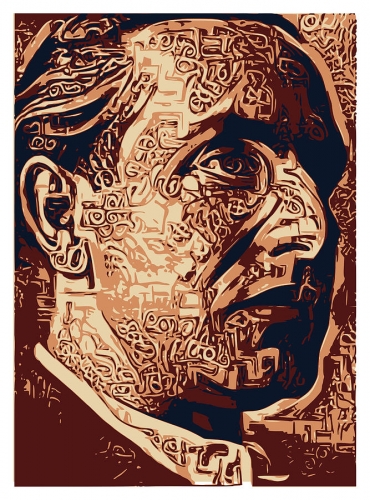
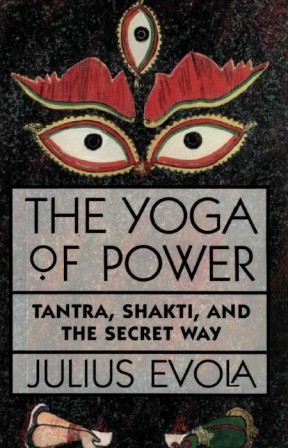 En 1926 parut: « L’homme en tant que puissance ». C’est un premier essai qui, bien des fois repris, donnera en 1949 « Le yoga tantrique, sa métaphysique, ses pratiques ». Evola s’ouvre à l’Orient, en l’occurrence à la tradition hindoue, et cela est d’autant plus intéressant que l’orient d’Evola n’est pas le même que celui de Guénon, il s’agit essentiellement de doctrines émanant de la caste des ksatriyas, la caste guerrière, et par cet aspect on trouve quelque chose qui consonne remarquablement avec l’ancienne tradition occidentale: il s’agit aussi de science « magique ». Prévenons tout de suite une équivoque possible : ce qu’Evola nomme magie n’a pas grand-chose à voir avec ce que désigne le mot dans le langage courant actuel. […]
En 1926 parut: « L’homme en tant que puissance ». C’est un premier essai qui, bien des fois repris, donnera en 1949 « Le yoga tantrique, sa métaphysique, ses pratiques ». Evola s’ouvre à l’Orient, en l’occurrence à la tradition hindoue, et cela est d’autant plus intéressant que l’orient d’Evola n’est pas le même que celui de Guénon, il s’agit essentiellement de doctrines émanant de la caste des ksatriyas, la caste guerrière, et par cet aspect on trouve quelque chose qui consonne remarquablement avec l’ancienne tradition occidentale: il s’agit aussi de science « magique ». Prévenons tout de suite une équivoque possible : ce qu’Evola nomme magie n’a pas grand-chose à voir avec ce que désigne le mot dans le langage courant actuel. […]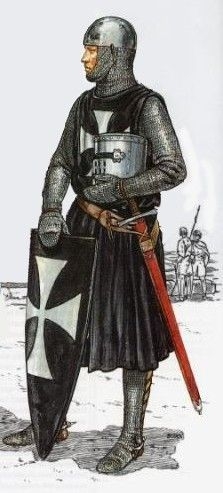 L’EPEE DE LUMIERE ET LE CHEVALIER D’OCCIDENT
L’EPEE DE LUMIERE ET LE CHEVALIER D’OCCIDENT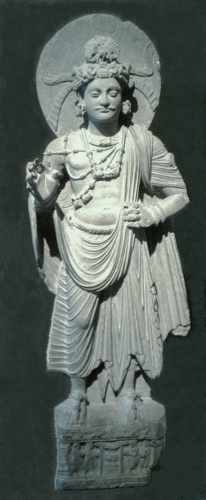 LA GRANDE LIBERATION DU PRINCE SIDDHARTA
LA GRANDE LIBERATION DU PRINCE SIDDHARTA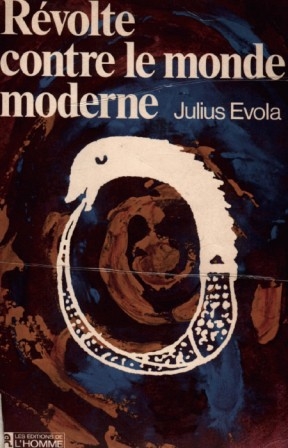 LES HOMMES AU MILIEU DES RUINES
LES HOMMES AU MILIEU DES RUINES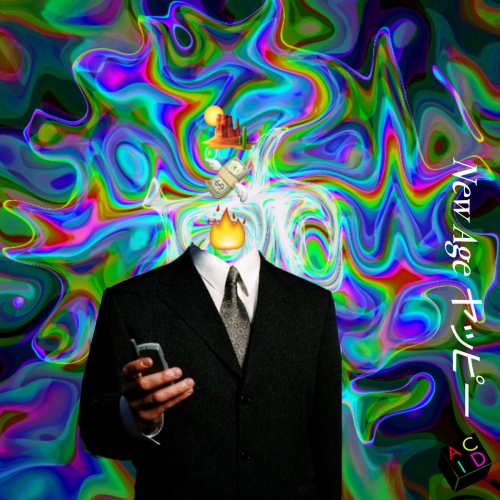
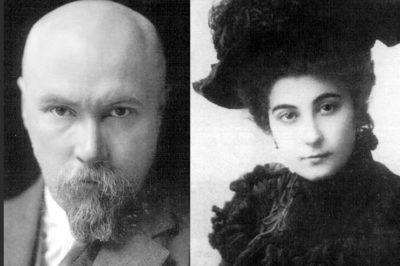
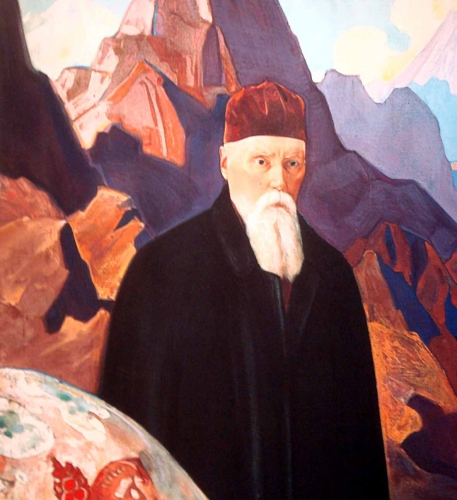
 After leaving Russia, the Roerichs and their two sons had first gone to Scandinavia, then made their way to England, eventually arriving on the shores of America. But the United States was not their ultimate destination. Their actual goal was India. For some years after 1917, India – the Raj – was closely maintained by the British who were constantly on guard against infiltration by Russian Bolsheviks bringing their inflammatory thoughts of revolution. The Roerichs were clearly on the list of those not wanted. In time, the way did open for them to enter India and although they never knew it, they were continually kept under surveillance. This fact accounts for many of their hardships.
After leaving Russia, the Roerichs and their two sons had first gone to Scandinavia, then made their way to England, eventually arriving on the shores of America. But the United States was not their ultimate destination. Their actual goal was India. For some years after 1917, India – the Raj – was closely maintained by the British who were constantly on guard against infiltration by Russian Bolsheviks bringing their inflammatory thoughts of revolution. The Roerichs were clearly on the list of those not wanted. In time, the way did open for them to enter India and although they never knew it, they were continually kept under surveillance. This fact accounts for many of their hardships. 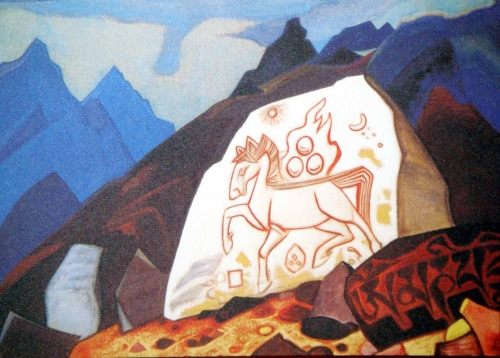
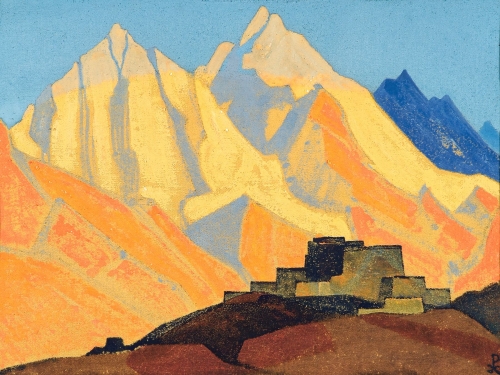
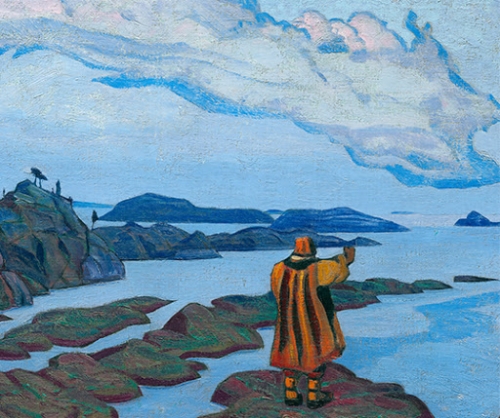
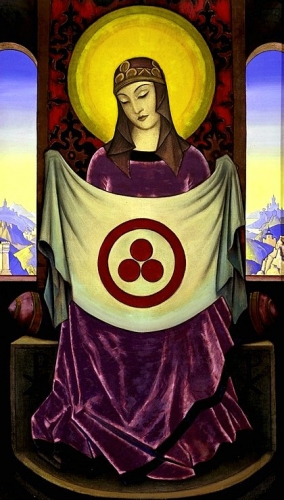
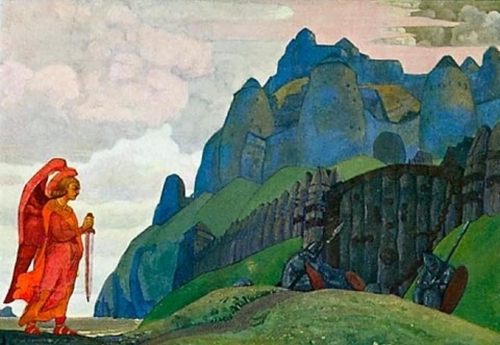
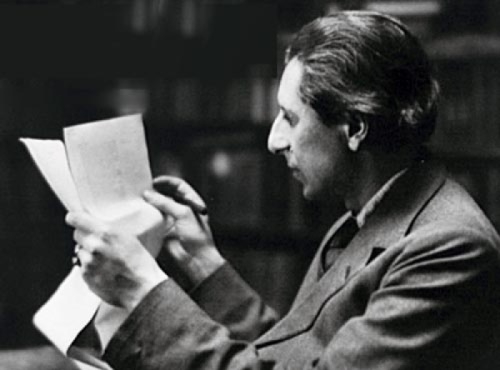
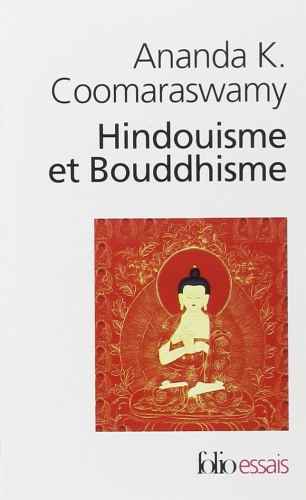 On sait ce que Guénon pensait de l’occident et de sa mission civilisatrice. On va rappeler le grand hindouiste de Ceylan Coomaraswamy (s’il voyait ce qu’on a fait de son île…) qui écrivait vers 1945 :
On sait ce que Guénon pensait de l’occident et de sa mission civilisatrice. On va rappeler le grand hindouiste de Ceylan Coomaraswamy (s’il voyait ce qu’on a fait de son île…) qui écrivait vers 1945 :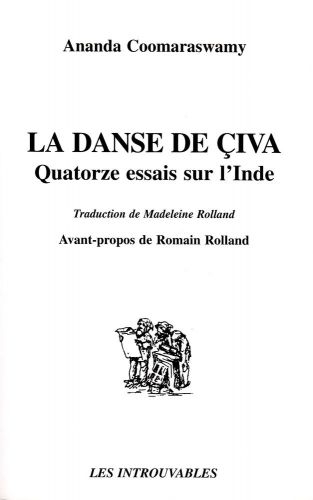 « M. Brailsford objecte que «les seuls obstacles à l’accroissement du commerce intérieur sur une échelle gigantesque sont la pauvreté des villages et l’autarcie qui est propre à leurs plus anciennes traditions... Il existe encore maint village, où les artisans héréditaires, qui servent pour une ration de grains ou quelques arpents de terre franche, tisseront les étoffes dont il aura besoin, forgeront ses houes et tourneront ses pots». Malheureusement, «l’accroissement du commerce intérieur sur une échelle gigantesque » n’est aucunement l’une de nos ambitions principales. Nous tenons encore (avec Philon, De Decalogo, 69) pour vérité patente que l’artisan est de valeur supérieure au produit de son métier, et nous avons conscience que c’est avant tout dans les sociétés industrielles que cette vérité est ignorée. »
« M. Brailsford objecte que «les seuls obstacles à l’accroissement du commerce intérieur sur une échelle gigantesque sont la pauvreté des villages et l’autarcie qui est propre à leurs plus anciennes traditions... Il existe encore maint village, où les artisans héréditaires, qui servent pour une ration de grains ou quelques arpents de terre franche, tisseront les étoffes dont il aura besoin, forgeront ses houes et tourneront ses pots». Malheureusement, «l’accroissement du commerce intérieur sur une échelle gigantesque » n’est aucunement l’une de nos ambitions principales. Nous tenons encore (avec Philon, De Decalogo, 69) pour vérité patente que l’artisan est de valeur supérieure au produit de son métier, et nous avons conscience que c’est avant tout dans les sociétés industrielles que cette vérité est ignorée. »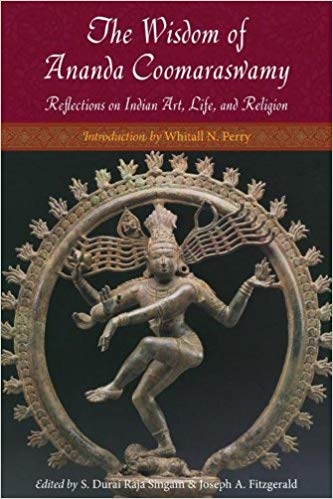 « Qu’avez-vous exactement à nous offrir, vous qui êtes si pénétrés de votre «mission civilisatrice»? N’êtes-vous point étonnés «qu’il n’y ait plus de peuple dans toute l’Asie qui ne regarde l’Europe avec crainte et soupçon», comme l’a dit Rabindranath Tagore, ou que nous redoutions la perspective d’une alliance des puissances impérialistes dont la «Charte de l’Atlantique» ne devait pas s’appliquer à l’Inde et ne s’appliquera pas à la Chine si on peut l’éviter? »
« Qu’avez-vous exactement à nous offrir, vous qui êtes si pénétrés de votre «mission civilisatrice»? N’êtes-vous point étonnés «qu’il n’y ait plus de peuple dans toute l’Asie qui ne regarde l’Europe avec crainte et soupçon», comme l’a dit Rabindranath Tagore, ou que nous redoutions la perspective d’une alliance des puissances impérialistes dont la «Charte de l’Atlantique» ne devait pas s’appliquer à l’Inde et ne s’appliquera pas à la Chine si on peut l’éviter? »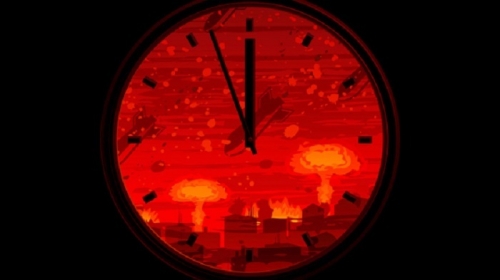
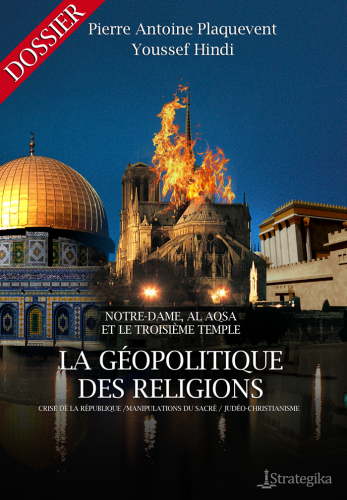
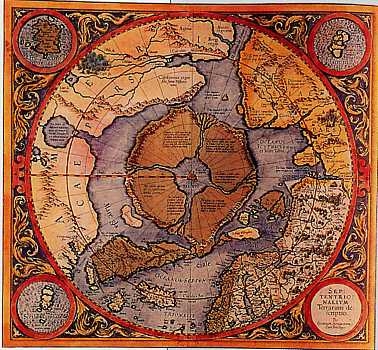

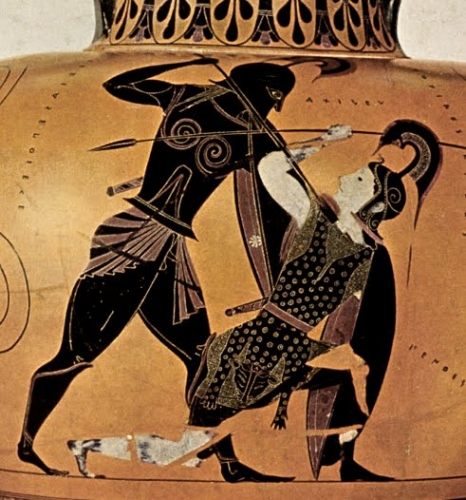
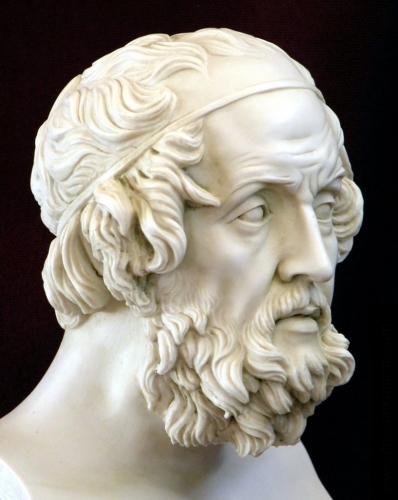 European culture formally began with the books of Homer. These European cultural stories were popularized in Europe approximately 3,000 years ago and then written down by the poet Homer about 2,700 years ago. One of the major themes in Homer is the concept of Xenia. Xenia defines the behavior expected from local European residents toward travelers, strangers, and even immigrants. Xenia also defines the behavior that is expected in return from these guests, these strangers in a strange land. The concepts presented in the Iliad and the Odyssey are considered the foundation of the European cultural tradition termed the code of hospitality or the code of courtesy.
European culture formally began with the books of Homer. These European cultural stories were popularized in Europe approximately 3,000 years ago and then written down by the poet Homer about 2,700 years ago. One of the major themes in Homer is the concept of Xenia. Xenia defines the behavior expected from local European residents toward travelers, strangers, and even immigrants. Xenia also defines the behavior that is expected in return from these guests, these strangers in a strange land. The concepts presented in the Iliad and the Odyssey are considered the foundation of the European cultural tradition termed the code of hospitality or the code of courtesy.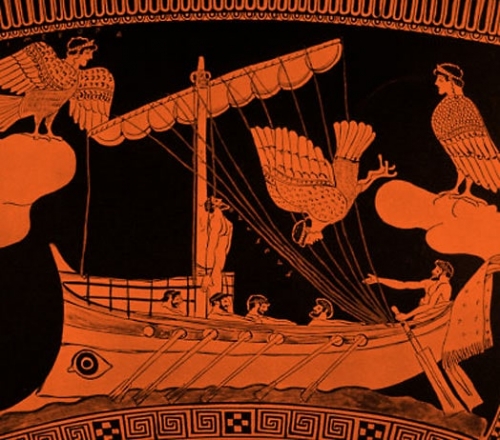
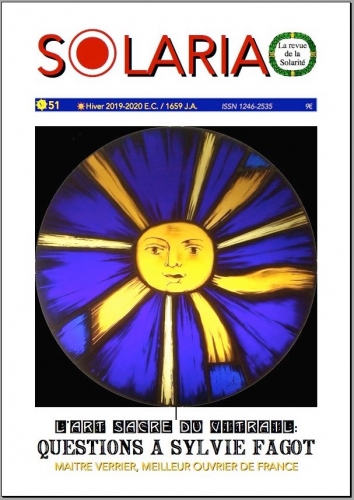
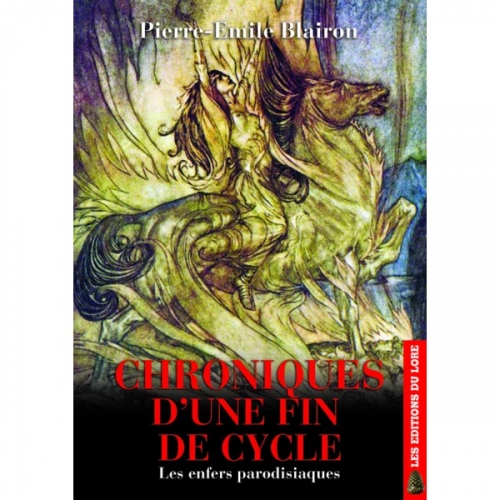
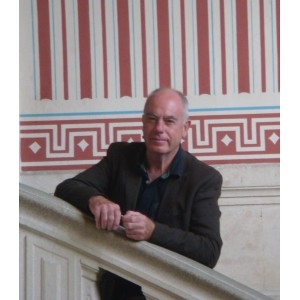 Dans le monde d’avant 1968, point de photographie du Président de la République française enlacé par deux jeunes hommes noirs, torses nus ; encore moins de plug anal géant défigurant la très distinguée place Vendôme à Paris. Et s’il n’y avait que cela…
Dans le monde d’avant 1968, point de photographie du Président de la République française enlacé par deux jeunes hommes noirs, torses nus ; encore moins de plug anal géant défigurant la très distinguée place Vendôme à Paris. Et s’il n’y avait que cela…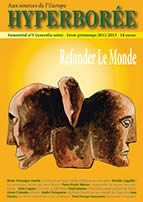 Il partage ses activités littéraires entre deux passions :
Il partage ses activités littéraires entre deux passions :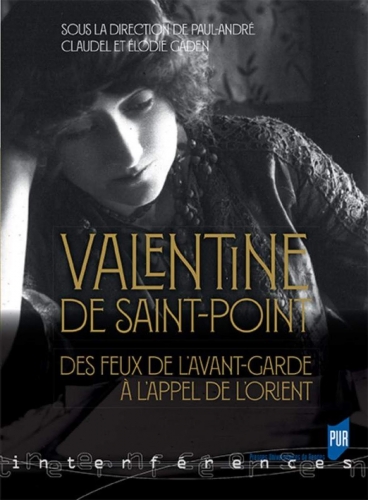
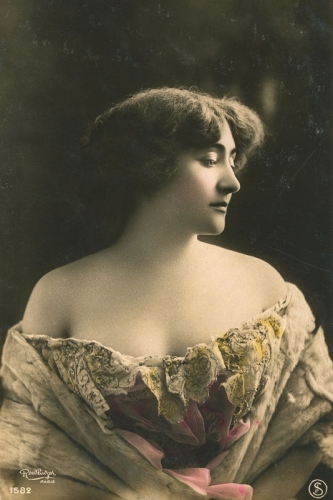
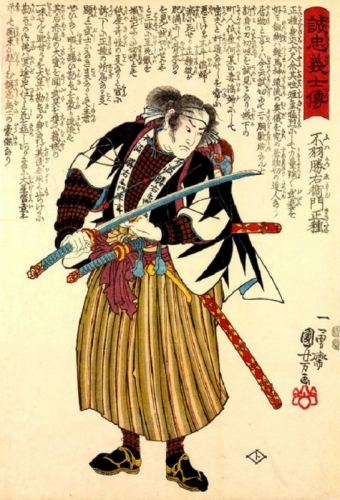
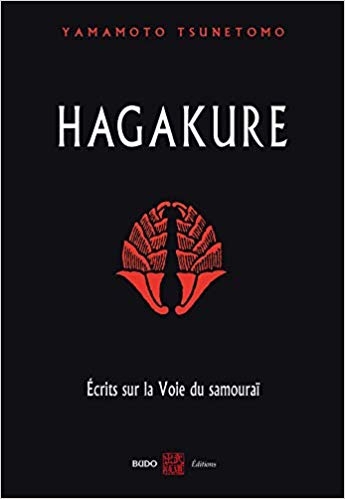 Jocho Yamamoto a « écrit » le traité Hagakure au début du siècle des Lumières, quand la crise européenne bat son plein. On passe en trente ans de Bossuet à Voltaire, comme a dit Paul Hazard, et cette descente cyclique est universelle, frappant France, Indes, catholicisme, Japon. J’ai beaucoup expliqué cette époque : retrouvez mes textes sur Voltaire ou sur Swift et la fin du christianisme (déjà…). Le monde moderne va se mettre en place. Mais c’est ce japonais qui alors a le mieux, à ma connaissance, décrit cette chute qui allait nous mener où nous en sommes. On pourra lire mes pages sur les 47 rônins (que bafoue Yamamoto !) dans un de mes livres sur le cinéma. Le Japon, comme dit notre génial Kojève, vit en effet une première Fin de l’Histoire avec cette introduction du shogunat et ce déclin des samouraïs, qui n’incarnèrent pas toujours une époque marrante comme on sait non plus. Voyez les films de Kobayashi, Kurosawa, Mizoguchi et surtout de mon préféré et oublié Iroshi Inagaki.
Jocho Yamamoto a « écrit » le traité Hagakure au début du siècle des Lumières, quand la crise européenne bat son plein. On passe en trente ans de Bossuet à Voltaire, comme a dit Paul Hazard, et cette descente cyclique est universelle, frappant France, Indes, catholicisme, Japon. J’ai beaucoup expliqué cette époque : retrouvez mes textes sur Voltaire ou sur Swift et la fin du christianisme (déjà…). Le monde moderne va se mettre en place. Mais c’est ce japonais qui alors a le mieux, à ma connaissance, décrit cette chute qui allait nous mener où nous en sommes. On pourra lire mes pages sur les 47 rônins (que bafoue Yamamoto !) dans un de mes livres sur le cinéma. Le Japon, comme dit notre génial Kojève, vit en effet une première Fin de l’Histoire avec cette introduction du shogunat et ce déclin des samouraïs, qui n’incarnèrent pas toujours une époque marrante comme on sait non plus. Voyez les films de Kobayashi, Kurosawa, Mizoguchi et surtout de mon préféré et oublié Iroshi Inagaki.
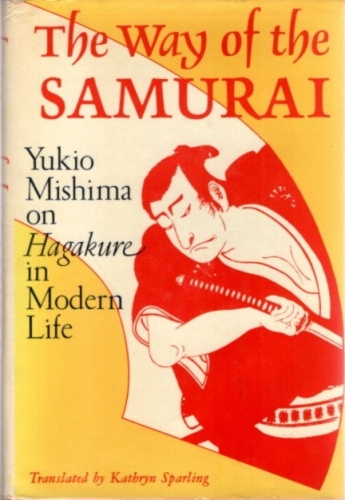 On pourra rappeler de belles analyses sur le roi Lear. On passe au métier de roi, dans la pièce de Shakespeare comme à la cour du roi de France (dixit Macluhan bien sûr au début de sa trop oubliée galaxie). Voyez aussi le Mondain de Voltaire.
On pourra rappeler de belles analyses sur le roi Lear. On passe au métier de roi, dans la pièce de Shakespeare comme à la cour du roi de France (dixit Macluhan bien sûr au début de sa trop oubliée galaxie). Voyez aussi le Mondain de Voltaire.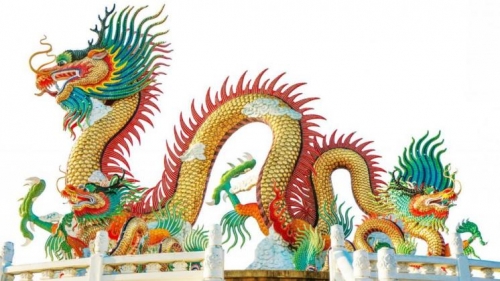
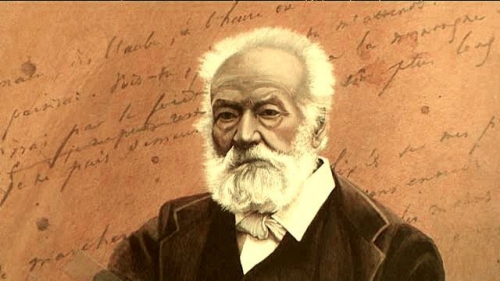
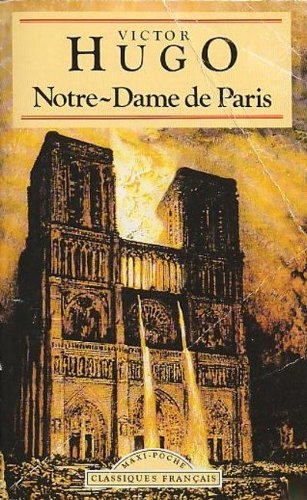 « Quand la mémoire des premières races se sentit surchargée, quand le bagage des souvenirs du genre humain devint si lourd et si confus que la parole, nue et volante, risqua d’en perdre en chemin, on les transcrivit sur le sol de la façon la plus visible, la plus durable et la plus naturelle à la fois. On scella chaque tradition sous un monument. » Ainsi Victor Hugo évoque-t-il le premier passage d’une ère d’oralité à un âge où l’architecture devient « le grand livre de l’humanité ». Souvenons-nous cependant de la parole biblique concernant la pierre que les bâtisseurs ont écartée et qui est justement la pierre d’angle. Le risque de « perdre en chemin » un élément essentiel deviendrait-il réalité dès que s’élèvent les premiers menhirs celtiques que l’on retrouve « dans la Sibérie d’Asie » ou « les pampas d’Amérique » ?
« Quand la mémoire des premières races se sentit surchargée, quand le bagage des souvenirs du genre humain devint si lourd et si confus que la parole, nue et volante, risqua d’en perdre en chemin, on les transcrivit sur le sol de la façon la plus visible, la plus durable et la plus naturelle à la fois. On scella chaque tradition sous un monument. » Ainsi Victor Hugo évoque-t-il le premier passage d’une ère d’oralité à un âge où l’architecture devient « le grand livre de l’humanité ». Souvenons-nous cependant de la parole biblique concernant la pierre que les bâtisseurs ont écartée et qui est justement la pierre d’angle. Le risque de « perdre en chemin » un élément essentiel deviendrait-il réalité dès que s’élèvent les premiers menhirs celtiques que l’on retrouve « dans la Sibérie d’Asie » ou « les pampas d’Amérique » ?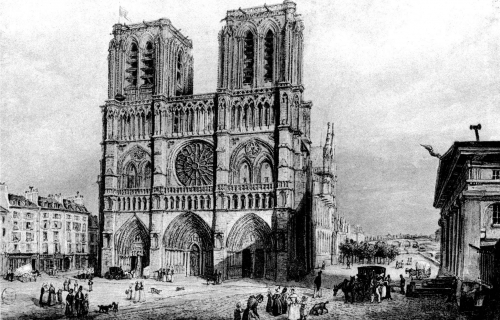
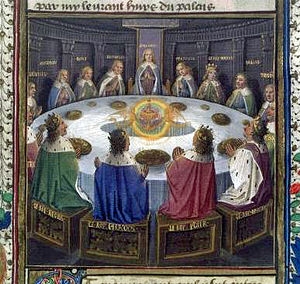 Le thème du Graal est l’équivalent païen, au sens noble du terme, de la pierre d’angle biblique rejetée par les bâtisseurs. Énigmatique demeure à mes yeux cette phrase de René Guénon : « Le Graal ne peut être qu’un zodiaque. » Mais je suis convaincu que, pour déchirer le voile qui recouvre le mystère des origines, pour retrouver ce « grain d’or » dont parle l’astronome Kepler (1571 – 1630), il faut emprunter la voie de l’astrologie, domaine impensé de notre mouvance intellectuelle (du moins à ma connaissance), art antique vénérable raillé par La Fontaine et Voltaire, discipline dévoyée depuis quatre siècles, hormis quelques soubresauts : le marquis de Boulainvilliers (1658 – 1722), une école française aux alentours de 1900 (Caslant, Choisnard, Boudineau), une école belge (avec Gustave-Lambert Brahy comme figure de proue), les travaux plus récents de Gauquelin et Barbault (tous deux nés en 1920). Si le Graal est un vase, ce n’est pas exclusivement parce que Joseph d’Arimathie y a recueilli le sang de Jésus crucifié, mais c’est, par-delà sa dérivation chrétienne, par son identification plus générale à un récipient recueillant la pluie des influences cosmiques. Cet élargissement de la signification du Graal s’inscrit, soit dans la « Préhistoire partagée (Raphaël Nicolle) » des peuples indo-européens, soit dans une proto-histoire plus ample, ainsi qu’en témoigne le rapprochement d’Hugo entre les pierres levées d’Europe occidentale et celle de l’Asie sibérienne et de l’Argentine.
Le thème du Graal est l’équivalent païen, au sens noble du terme, de la pierre d’angle biblique rejetée par les bâtisseurs. Énigmatique demeure à mes yeux cette phrase de René Guénon : « Le Graal ne peut être qu’un zodiaque. » Mais je suis convaincu que, pour déchirer le voile qui recouvre le mystère des origines, pour retrouver ce « grain d’or » dont parle l’astronome Kepler (1571 – 1630), il faut emprunter la voie de l’astrologie, domaine impensé de notre mouvance intellectuelle (du moins à ma connaissance), art antique vénérable raillé par La Fontaine et Voltaire, discipline dévoyée depuis quatre siècles, hormis quelques soubresauts : le marquis de Boulainvilliers (1658 – 1722), une école française aux alentours de 1900 (Caslant, Choisnard, Boudineau), une école belge (avec Gustave-Lambert Brahy comme figure de proue), les travaux plus récents de Gauquelin et Barbault (tous deux nés en 1920). Si le Graal est un vase, ce n’est pas exclusivement parce que Joseph d’Arimathie y a recueilli le sang de Jésus crucifié, mais c’est, par-delà sa dérivation chrétienne, par son identification plus générale à un récipient recueillant la pluie des influences cosmiques. Cet élargissement de la signification du Graal s’inscrit, soit dans la « Préhistoire partagée (Raphaël Nicolle) » des peuples indo-européens, soit dans une proto-histoire plus ample, ainsi qu’en témoigne le rapprochement d’Hugo entre les pierres levées d’Europe occidentale et celle de l’Asie sibérienne et de l’Argentine.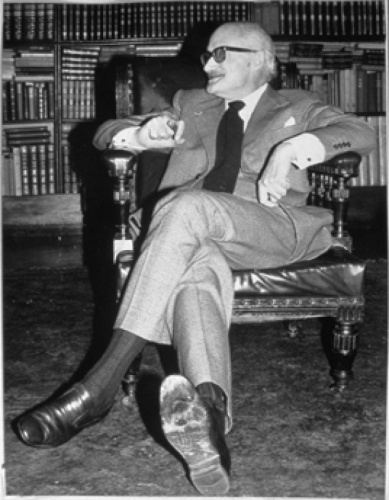
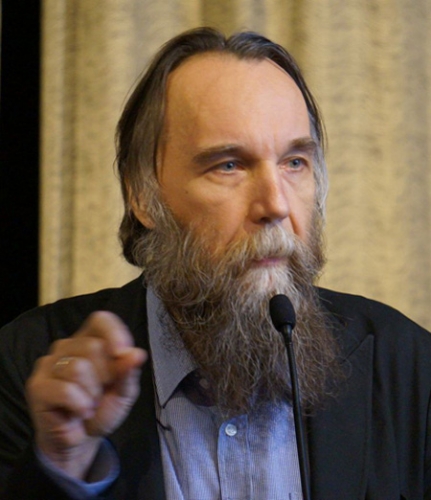 Meanwhile for the liberal, the reason that the radical displays its creation of the human will which aspire for absolute freedom.
Meanwhile for the liberal, the reason that the radical displays its creation of the human will which aspire for absolute freedom.